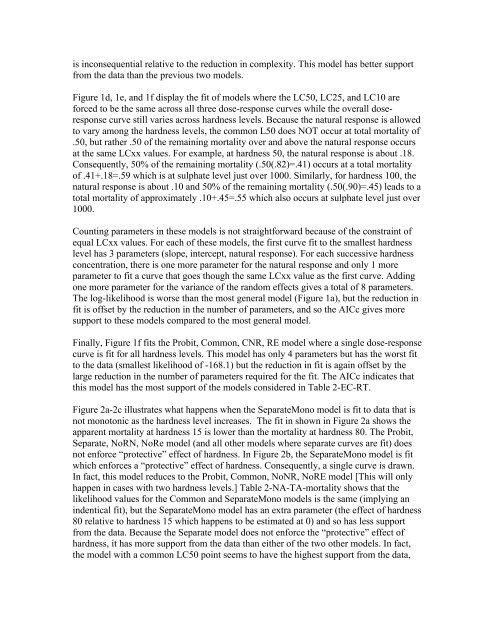Summary - People.stat.sfu.ca - Simon Fraser University
Summary - People.stat.sfu.ca - Simon Fraser University
Summary - People.stat.sfu.ca - Simon Fraser University
Create successful ePaper yourself
Turn your PDF publications into a flip-book with our unique Google optimized e-Paper software.
is inconsequential relative to the reduction in complexity. This model has better supportfrom the data than the previous two models.Figure 1d, 1e, and 1f display the fit of models where the LC50, LC25, and LC10 areforced to be the same across all three dose-response curves while the overall doseresponsecurve still varies across hardness levels. Be<strong>ca</strong>use the natural response is allowedto vary among the hardness levels, the common L50 does NOT occur at total mortality of.50, but rather .50 of the remaining mortality over and above the natural response occursat the same LCxx values. For example, at hardness 50, the natural response is about .18.Consequently, 50% of the remaining mortality (.50(.82)=.41) occurs at a total mortalityof .41+.18=.59 which is at sulphate level just over 1000. Similarly, for hardness 100, thenatural response is about .10 and 50% of the remaining mortality (.50(.90)=.45) leads to atotal mortality of approximately .10+.45=.55 which also occurs at sulphate level just over1000.Counting parameters in these models is not straightforward be<strong>ca</strong>use of the constraint ofequal LCxx values. For each of these models, the first curve fit to the smallest hardnesslevel has 3 parameters (slope, intercept, natural response). For each successive hardnessconcentration, there is one more parameter for the natural response and only 1 moreparameter to fit a curve that goes though the same LCxx value as the first curve. Addingone more parameter for the variance of the random effects gives a total of 8 parameters.The log-likelihood is worse than the most general model (Figure 1a), but the reduction infit is offset by the reduction in the number of parameters, and so the AICc gives moresupport to these models compared to the most general model.Finally, Figure 1f fits the Probit, Common, CNR, RE model where a single dose-responsecurve is fit for all hardness levels. This model has only 4 parameters but has the worst fitto the data (smallest likelihood of -168.1) but the reduction in fit is again offset by thelarge reduction in the number of parameters required for the fit. The AICc indi<strong>ca</strong>tes thatthis model has the most support of the models considered in Table 2-EC-RT.Figure 2a-2c illustrates what happens when the SeparateMono model is fit to data that isnot monotonic as the hardness level increases. The fit in shown in Figure 2a shows theapparent mortality at hardness 15 is lower than the mortality at hardness 80. The Probit,Separate, NoRN, NoRe model (and all other models where separate curves are fit) doesnot enforce “protective” effect of hardness. In Figure 2b, the SeparateMono model is fitwhich enforces a “protective” effect of hardness. Consequently, a single curve is drawn.In fact, this model reduces to the Probit, Common, NoNR, NoRE model [This will onlyhappen in <strong>ca</strong>ses with two hardness levels.] Table 2-NA-TA-mortality shows that thelikelihood values for the Common and SeparateMono models is the same (implying anindenti<strong>ca</strong>l fit), but the SeparateMono model has an extra parameter (the effect of hardness80 relative to hardness 15 which happens to be estimated at 0) and so has less supportfrom the data. Be<strong>ca</strong>use the Separate model does not enforce the “protective” effect ofhardness, it has more support from the data than either of the two other models. In fact,the model with a common LC50 point seems to have the highest support from the data,
















